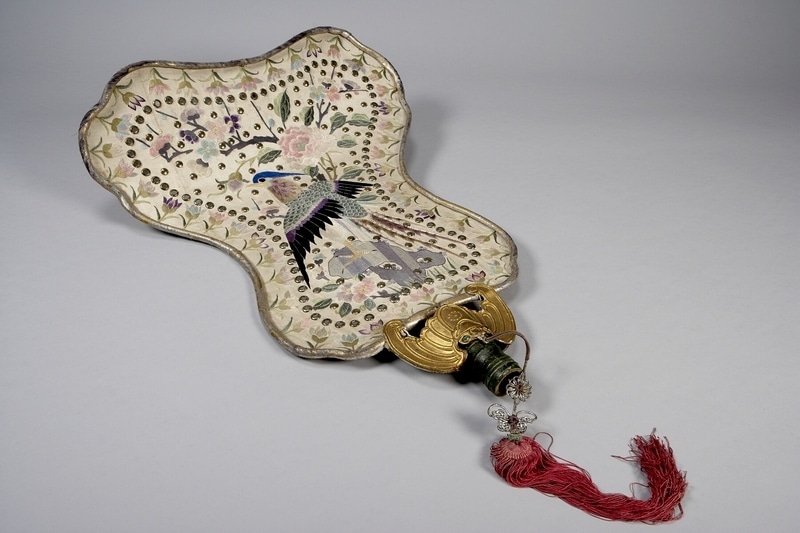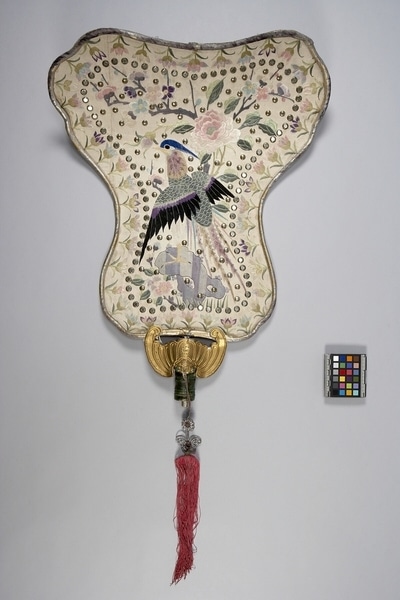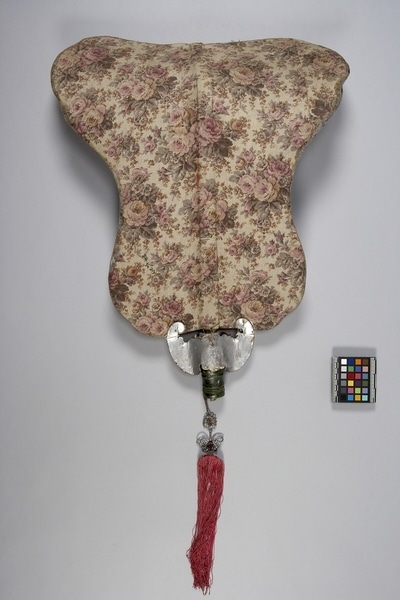Cantonese Opera Fan Item Number: N1.737 a from the MOA: University of British Columbia



Description
A shield-shaped fan made of cardboard with a heavy rolled edge of fabric supported by a wood socket and slat running up the centre back. The concave front has a main design consisting of a bird facing to its right on a peony tree among prunus motifs with turquoise, blue, black, pink, mauve, grey, and pale green bordered by tin reflectors, mirrors, on an ivory-coloured background. The top of the bird's head is blue, and the middle of its wings are purple. A golden bat is at the base with an attached deep pink tassel. The convex back has a printed rose design, 18th century style, on cotton.
History Of Use
Such fans were used in imperial settings on the Cantonese opera stage of the period, which otherwise was nearly bare. Scenery was not used, and settings were indicated by a few props, by the use of mime and gesture, and sometimes by signs stating the nature of the setting. They were carried in procession or held by standing attendants at either side behind an emperor and/or empress during imperial rites. They always were used in pairs.
Cultural Context
theatre
Iconographic Meaning
The shape and nature of such fans and the respectful way they were held signaled the presence of an emperor or empress.
Narrative
A large group of Cantonese opera costumes, musical instruments, props, trunks, and stage fittings was left with the Jin Wah Sing Musical Association, apparently by some of the many itinerant troupes visiting Vancouver to perform in the Chinatown theatres in the pre World War II period. There is no certain knowledge of why these materials were not taken back to China by them. They were used by the Jin Wah Sing Musical Association in their performances until they became too dated. The association continued to preserve them carefully, storing them in their headquarters and in the basement of the Chinese Freemasons building until several groups of materials were sold and donated to the Museum of Anthropology.
Item History
- Made in Guangzhou, Guangdong, China ? during 1920
- Collected in Vancouver, British Columbia, Canada
- Owned by Jin Wah Sing Musical Association before August 28, 1973
- Received from Barrett Montford Endowment Fund (Funding source), Jin Wah Sing Musical Association (Seller), Leon & Thea Koerner Foundation (Funding source), Museum of Anthropology Donations Fund (Funding source), Mah Society of North America (Funding source), Canada-China Friendship Association (Funding source), Quon H. Wong Agencies (Funding source) and Edith Low-Beer (Funding source) on August 28, 1973
What
- Name
- Cantonese Opera Fan
- Identification Number
- N1.737 a
- Type of Item
- fan
- Material
- silk fibre, cotton fibre, wood, paper, paste adhesive, brass metal, silver metal, glass and paint
- Manufacturing Technique
- spun, woven, cut, embroidered, couched, applied, smoothed, painted, braided, knotted and adhered
- Overall
- height 104.0 cm, width 51.0 cm, depth 17.4 cm
Who
- Culture
- Chinese: Cantonese
- Previous Owner
- Jin Wah Sing Musical Association
- Received from
- Barrett Montford Endowment Fund (Funding source), Jin Wah Sing Musical Association (Seller), Leon & Thea Koerner Foundation (Funding source), Museum of Anthropology Donations Fund (Funding source), Mah Society of North America (Funding source), Canada-China Friendship Association (Funding source), Quon H. Wong Agencies (Funding source) and Edith Low-Beer (Funding source)
Where
- Holding Institution
- MOA: University of British Columbia
- Made in
- Guangzhou, Guangdong, China ?
- Collected in
- Vancouver, British Columbia, Canada
When
- Creation Date
- during 1920
- Ownership Date
- before August 28, 1973
- Acquisition Date
- on August 28, 1973
Other
- Item Classes
- textiles
- Condition
- fair
- Accession Number
- 0248/0122 a